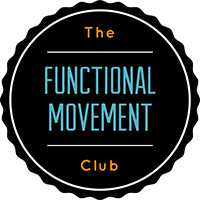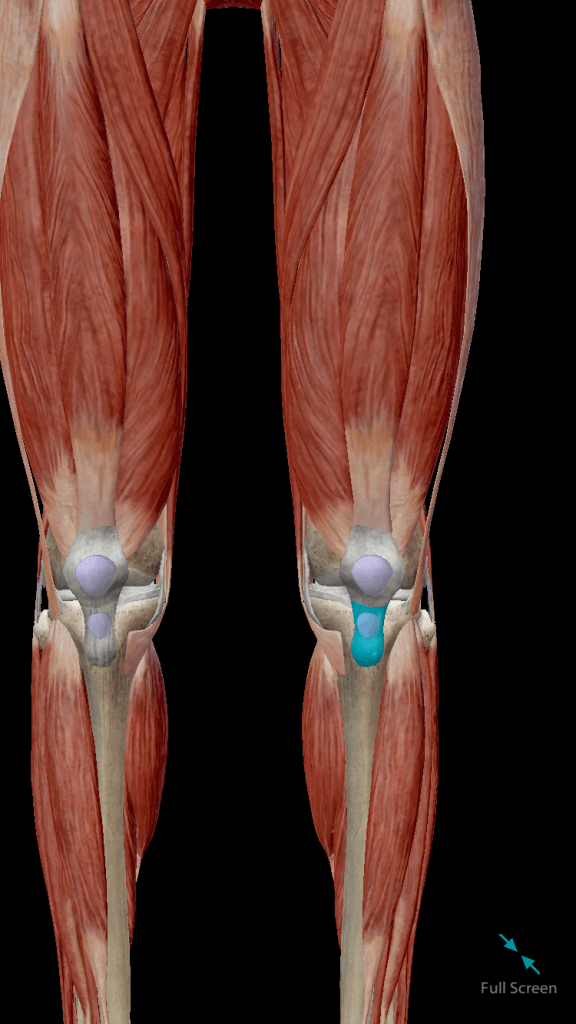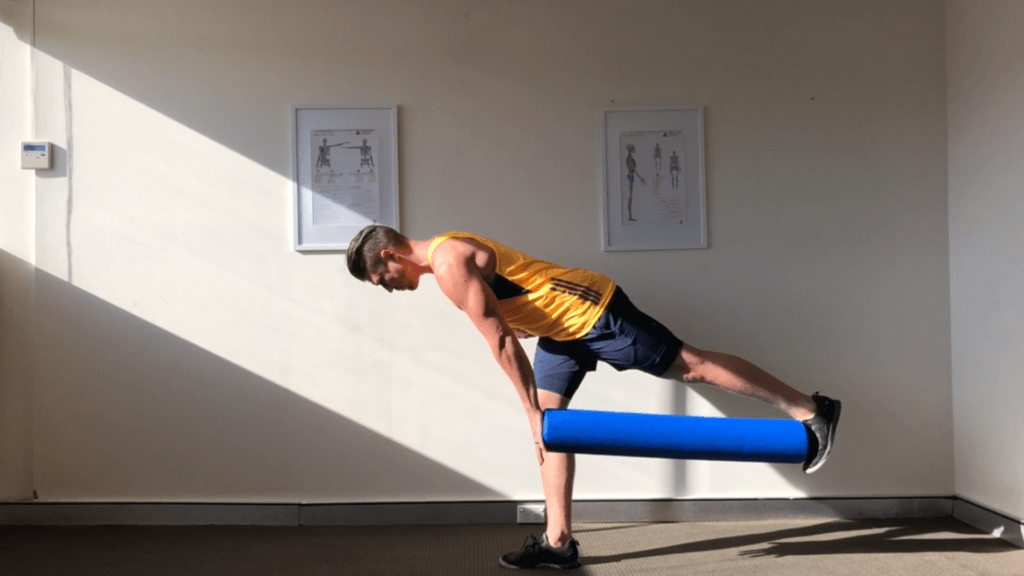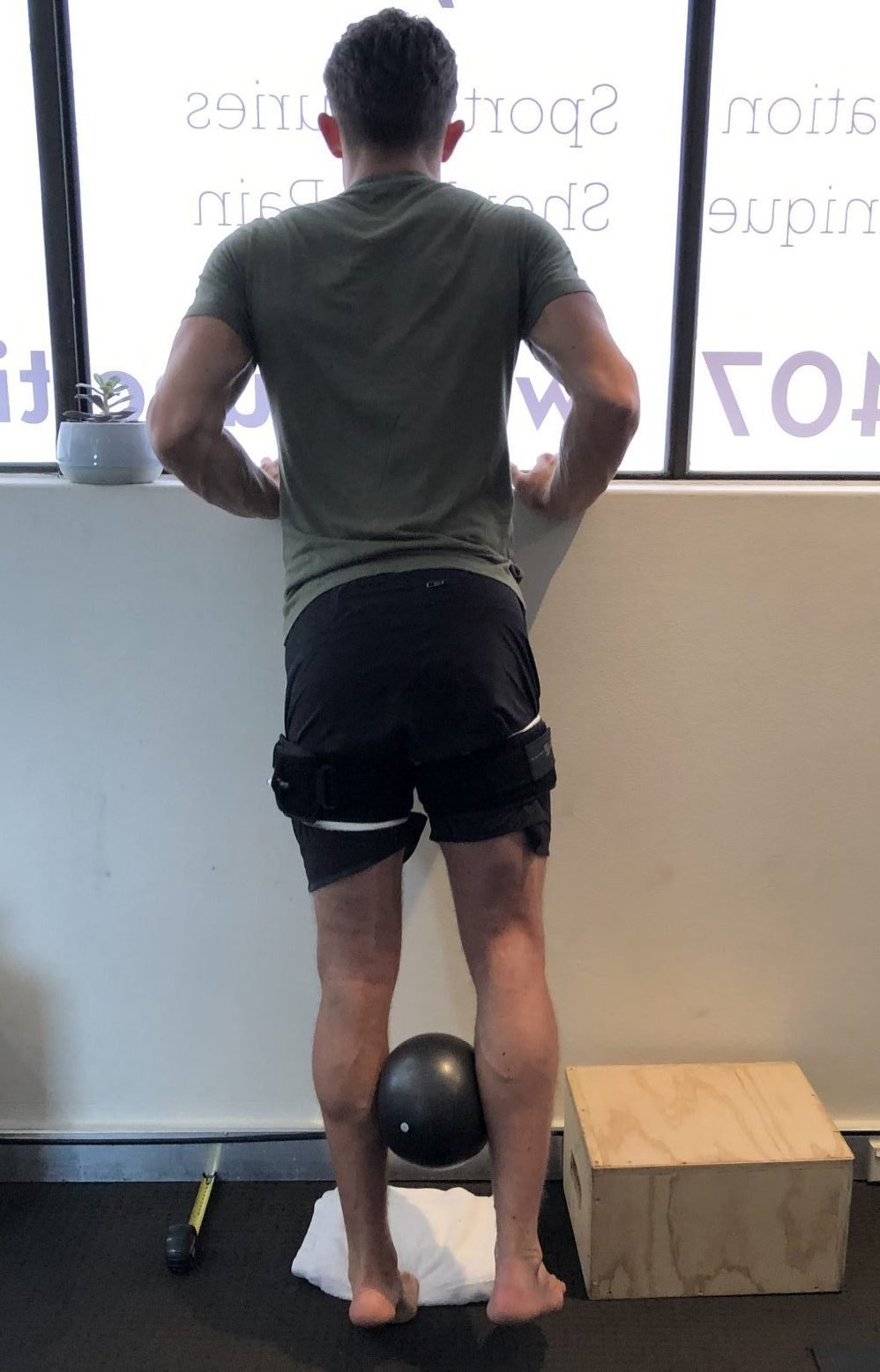
Blood Flow Restriction Training – What You Need To Know
What Is Blood Flow Restriction Training?
Blood Flow Restriction Training (BFRT) is brief bouts of exercise with restriction of venous blood flow restriction. The restriction is applied via tourniquet which is applied to either the Upper limb/s or lower limb/s. BFRT is also referred to as: occlusion training, low intensity occlusion training, vascular occlusion training, muscle occlusion training, hypoxic training, or KAATSU.
It has been found to improve localised muscle adaptations as well as systemic (whole body) changes. Studies show improvement in cardiovascular endurance with low intensity exercise or low resistance training (as low as 20-30% 1 rep max).
Uses for BFRT:
- Effective for Rehabilitation
- Aids Recovery
- Improving Cardiovascular Function
The researched benefits of BFRT include:
- Increased Strength
- Increasing Muscle Growth (Hypertrophy)
- Limiting Muscle wastage (Atrophy)
How Blood Flow Restriction Training Works:
The Use of tourniquet (blood flow restriction cuff) increases cellular swelling, allowing the venous blood supply to pool in the occluded limb whilst the workout is complete. As soon as the cuff is release, an influx of oxygenated blood flows into the tissues and helps to speed up the muscle repair phase.
The cellular swelling increases blood lactate level (think lactic acid) which stimulates the body to produce more growth hormone and insulin like growth factor 1 (IGF-1). Growth hormone is responsible to collagen synthesis which is an important part of tissue repair and recovery. IGF-1 is linked with increased muscle growth. Another molecule responsible for cellular growth is Rapamycin (mTORC2) which is also stimulated post BFRT.
When the muscles working under anaerobic (non-oxygenated) conditions, it increases muscle fatigue quicker under a lower load due to increased muscle fibre recruitment. Which then leads to increased muscle protein synthesis. This increased muscle protein synthesis can last for up to 24 hrs post exercise.
Muscle recruitment under hypoxic conditions is also increased, which leads to more muscle fibres being trained, and increases in strength and muscle. As more muscle fibres are recruited and less reps are required to failure, you do not break down as much muscle tissue. The fact that you aren’t breaking down as much tissue with training means the delayed onset muscle soreness (DOMS) is decreased with BFRT when compared to conventional resistance training with similar loads.
A combination of blood pooling, accumulation of metabolites, and reactive hyperaemia following the removal of venous blood flow restriction (VBFR) which may contribute to skeletal muscle adaptions that occur with VBFR.
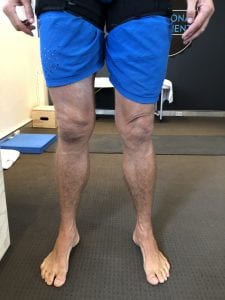
Leg Size pre Blood Flow Restriction Training
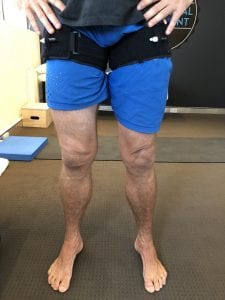
Cellular Swelling Post Blood Flow Restriction Training
Blood Flow Restriction Training For Hypertrophy:
- Muscular size increased following resistance training in a hypoxic environment
- Able to train at 20% 1RM and still result in significant improvements of Hypertrophy
- GH also increase insulin like growth factor (IGF-1), which is a protein linked to muscle growth
- IGF-1 also increase satellite cell proliferation and therefore increase muscle mass
Blood Flow Restriction Training For Strength:
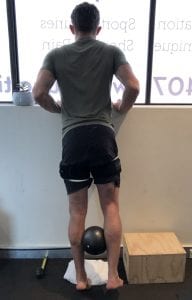
- Increased cross sectional recruitment of muscle fibres
- Increased muscle protein synthesis
- Able to train at 20% 1RM and still result in significant improvements of strength
Blood Flow Restriction Training For Endurance:
- Walking exercise with BFRT has been shown to improve the venous compliance compared to walking without blood flow restriction
- BFRT has been shown to result in a 30% reduction in the number of repetitions to failure
- It improves microvascular filtration capacity which is the ability for your body to filter the blood and excrete the molecules within blood responsible for repair and recovery
- Enhanced levels of vascular endothelial growth factor, which is a protein associated with the formation of new capillaries and improvements in oxygen delivery to existing skeletal muscle
Who Would Benefit from BFRT:
Anyone looking to increase muscle size, muscle strength or muscle endurance, some examples of populations studied include:
- Pre or Post-surgical rehabilitation
- People unable to train with regular loads
- Anyone looking to improve performance (Strength/endurance/power).
Is Blood Flow Restriction Training Safe?
When conducted with proper equipment under supervision yes, but as with all exercise should be monitored and check with a health care professional first. Precautions on top of normal pre exercise checklist include risk of thrombus (blood clot) formation, cardiovascular responses to exercise and numbness due to compression of vascular (veins and arteries) and nerves. Several studies have reported the following with regards to these concerns:
- No change in blood markers for thrombin generation or intravascular clot formation
- Possibility of intensified exercise pressure reflex (EPR) a reflex that contributes to cardiovascular modification during exercise from the autonomic nervous system, this can be mitigated by using relative cuff inflation pressures and reducing the BFR pressure
- Numbness may occur due to inappropriately high cuff pressures – this is mitigated with appropriate selection of cuff size and pressure
BFRT is NOT Suitable For:
- Patients with poor circulation systems
- Diabetes
- Cardiopulmonary conditions
- Infections
- People currently taking antihypertensives
- Patients with diagnosed with Cancer
Exercises Prescription:
Current recommendation for BFRT are 2-3 resistance or endurance session per week, ideally at a higher repetition volume in the vicinity of 75 reps (30,15,15,15) with a 30 second rest in between sets.
The goal of BFRT is to get metabolite accumulation (lactate) which increases in serum growth hormone which increases collagen synthesis for tissue repair and recovery along with IGF-1
Significant changes in strength will initially occur due to neural adaptions with long term strength gains being noticeable after 10+ weeks.
Intensities as low as 30% of Heart Rate Reserve (HRR), for 10-15 min, 2-3/7 for 6 weeks has shown improvement with cardiovascular improvement
Cuff width, cuff pressure, continuous vs intermittent pressure all affects effectiveness. Cuff pressure shoulder be between 40-90% of the individuals Arterial Occlusion pressure (AOP). Absolute pressure varies depending on cuff width. Wider cuffs have a lower absolute AOP then a narrower cuff and results in less stress on the individual when training
Conclusion:
Uses for BFRT:
- Effective for Rehabilitation
- Aids Recovery
- Improving Cardiovascular Function
The researched benefits of BFRT include:
- Increased Strength
- Increasing Muscle Growth (Hypertrophy)
- Limiting Muscle wastage (Atrophy)
Precautions:
As with all exercise, consultation with a health care professional should be sought to check if this type of exercise program is suitable for your specific needs.
Exercise Prescription:
- 2-3 resistance or endurance session per week,
- higher repetition volume in the vicinity of 75 reps (30,15,15,15)
- 30 second rest in between sets.
Need Some Help With Your Mobility:
Check out our Better Mobility Program.(Click Here)
References:
- Abe, T., Fujita, S., Nakajima, T., Sakamaki, M., Ozaki, H., Ogasawara, R., Sugaya, M., Kudo, M., Kurano, M., Yasuda, T., Sato, Y., Ohshima, H., Mukai, C. & Ishii, N. (2010). Effects of Low-Intensity Cycle Training with Restricted Leg Blood Flow on Thigh Muscle Volume and VO2MAX in Young Men. Journal of Sports Science and Medicine, 9(3), 452-8. [PubMed]
- Abe, T., Kearns, C. F., Manso Filho, H. C., Sato, Y., McKeever, K. H. (2006a). Muscle, tendon, and somatotropin responses to the restriction of muscle blood flow induced by KAATSU-walk training. Equine Vetinary Journal. Supplement, 36, 345-8. [PubMed]
- Abe, T., Kearns, C. F. and Sato, Y. (2006b). Muscle size and strength are increased following walk training with restricted venous blood flow from the leg muscle, Kaatsu-walk training. Journal of Applied Physiology, 100(5), 1460-6. [PubMed]
- Alberti, G. A., Cavaggioni, L., Silvaggi, N. & Caumo, A. (2013). Resistance training with blood flow restriction using the modulation of the muscle’s contraction velocity. Strength and Conditioning Journal, 35(1), 42-47. [SCJ]
- Araujo, J. P., Silva, E. D., Silva, J. C., Souza, T. S., Lima, E. O., Guerra, I. & Sousa, M. S. (2014). The acute effect of resistance exercise with blood flow restriction with hemodynamic variables on hypertensive subjects. Journal of Human Kinetics, 12, 79-85. [PubMed]
- Barcelos, L. C., Nunes, P. R., de Souza, L. R., de Oliveira, A. A., Furlanetto, R., Marocolo, M. & Orsatti, F. L. (2015). Low-load resistance training promotes muscular adaptation regardless of vascular occlusion, load, or volume.European Journal of Applied Physiology. [PubMed]
- Brandner, C. R., Kidgell, D. J. & Warmington, S. A. (2014). Unilateral biceps curl hemodynamics: Low pressure continuous vs high pressure intermittent blood flow restriction. Scandinavian Journal of Medicine and Science in Sports.[PubMed]
- Cayot, T. E., Lauver, J. D., Cillete, C. R. & Scheuermann, B. W. (2015). Effects of blood flow restriction duration on muscle activation and microvascular oxygenation during low-volume isometric exercise. Clinical Physiology and Functional Imaging. [PubMed]
- Clark, B. C., Manini, T. M., Hoffman, R. L., Williams, P. S., Guiler, M. K., Knutson, M. J., McGlynn, M. L., Kushnick, M. R. (2011). Relative safety of 4 weeks of blood flow-restricted resistance exercise in young healthy adults.Scandinavian Journal of Medicine and Science in Sports, 21(5), 653-62. [PubMed]
- Cook, S. B., Brown, K. A., Deruisseau, K., Kanaley, J. A. & Ploutz-Snyder, L. L. (2010). Skeletal muscle adaptations following blood flow-restricted training during 30 days of muscular unloading. Journal of Applied Physiology, 109(2), 341-9. [PubMed]
- Cook, S. B., Clark, B. C. & Ploutz-Snyder, L. L. (2007). Effects of exercise load and blood-flow restriction on skeletal muscle function. Medicine and Science in Sports and Exercise, 39(10), 1708-13. [PubMed]
- Cook, C. J., Kilduff, L. P. & Beaven, C. M. (2014). Improving strength and power in trained athletes with 3 weeks of occlusion training. International Journal of Sports Physiology and Performance, 9(1), 166-72. [PubMed]
- Cumming, K. T., Paulsen, G., Wernbom, M., Ugelstad, I. & Raastad, T. (2014). Acute response and subcellular movement of HSP27, αB-crystallin and HSP70 in human skeletal muscle after blood-flow-restricted low-load resistance exercise. Acta Physiologica, 211(4), 634-46. [PubMed]
- Dorneless, G. P., Colato, A. S., Galvao, S. L., Ramis, T. R., Ribeiro, J. L., Romao, P. R. & Peres, A., (2015). Acute response of peripheral CCr5 chemoreceptor and NK cells in individuals submitted to a single session of low-intensity strength exercise with blood flow restriction. Clinical Physiology and Functional Imaging. [PubMed]
- Drummond, M. J., Fujita, S., Abe, T., Dreyer, H. C., Volpi, E. & Rasmussen, B. B. (2008). Human muscle gene expression following resistance exercise and blood flow restriction. Medicine and Science in Sports and Exercise, 40(4), 691-8. [PubMed]
- Edgarton, T, (2018), Blood flow restriction training, https://www.strengthandconditioningresearch.com/blood-flow-restriction- training-bfr/
- Evans, C., Vance, S. & Brown, M. (2010). Short-term resistance training with blood flow restriction enhances microvascular filtration capacity of human calf muscles. Journal of Sports Sciences, 28(9), 999-1007. [PubMed]
- Fahs, C. A., Loenneke, J. P., Rossow, L. M., Thiebaud, R. S. & Bemben, M. G. (2012). Methodological considerations for blood flow restricted resistance exercise. Journal of Trainology, 1, 14-22 [Trainology]
- Fahs, C. A., Loenneke, J. P., Theabaud, R. S., Rossow, L. M., Kim, D., Abe, T., Beck, T. W., Feeback, D. L., Bemben, D. A. & Bemben, M. G. (2014a). Muscular adaptations to fatiguing exercise with and without blood flow restriction.Clinical Physiology and Functional Imaging. [PubMed]
- Fahs, C. A., Rossow, L. M., Loenneke, J. P., Thiebaud, R. S., Kim, D., Bemben, D. A. & Bemben, M. G. (2012b). Effect of different types of lower body resistance training on arterial compliance and calf blood flow. Clinical Physiology and Functional Imaging, 32(1), 45-51 [PubMed]
- Fahs, C. A., Rossow, L. M., Thiebaud, R. S., Loenneke, J. P., Kim, D., Abe, T., Beck, T. W., Feeback, D. L., Bemben, D. A. & Bemben, M. G. (2014b). Vascular adaptations to low-load resistance training with and without blood flow restriction. European Journal of Applied Physiology, 114(4), 715-24. [PubMed]
- Fitschen, P. J., Kistler, B. M., Jeong, J. H., Chung, H. R., Wu, P. T., Walsh, M. J. & Wilund, K. R. (2014). Perceptual effects and efficacy of intermittent or continuous blood flow restriction resistance training. Clinical Physiology and Functional Imaging34(5), 356-63. [PubMed]
- Fry, C. S., Glynn, E. L., Drummond, M. J., Timmerman, K. L., Fujita, S., Abe, T., Dhanani, S., Volpi, E., & Rasmussen, B. B. (2010). Blood flow restriction exercise stimulates mTORC1 signaling and muscle protein synthesis in older men.Journal of Applied Physiology, 108(5), 1199-209.[PubMed]
- Fujita, S., Abe, T., Drummond, M. J., Cadenas, J. G., Dreyer, H. C., Sato, Y., Volpi, E. & Rasmussen, B. B. (2007). Blood flow restriction during low-intensity resistance exercise increases S6K1 phosphorylation and muscle protein synthesis. Journal of Applied Physiology, 10(3), 903-10. [PubMed]
- Godawa, T. M., Credeur, D. P. & Welsch, M. A. (2012). Influence of compressive gear on powerlifting performance: role of blood flow restriction training. Journal of Strength and Conditioning Research, 26(5), 1274-80. [PubMed]
- Gundermann, D. M., Fry, C. S., Dickinsen, J. M., Walker, D. K., Timmerman, K. L., Drummond, M. J., Volpi, E. & Rasmussen, B. B. (2012). Reactive hyperemia is not responsible for stimulating muscle protein synthesis following blood flow restriction exercise. Journal of Applied Physiology, 112(9), 1520-8. [PubMed]
- Gundermann, D. M., Walker, D. K., Reidy, P. T., Borack, M. S., Dickinson, J. M.Volpi, E. & Rasmussen, B. B. (2014). Activation of mTORC1 signaling and protein synthesis in human muscle following blood flow restriction exercise is inhibited by rapamycin. American Journal of Physiology Endocrinology and Metabolism, 306(10), E1198-204. [PubMed]
- Heitkamp, H. C. (2015). Training with blood flow restriction: mechanisms, gain in strength and safety. Journal of Sports Medicine and Physical Fitness. [PubMed]
- Horiuchi, M. and Okita, K. (2012). Blood flow restricted exercise and vascular function. International Journal of Vascular Medicine, 543218. [PubMed]
- Hunt, J. E., Galea, D., Tufft, G., Bunce, D. & Ferguson, R. A. (2013). Time course of regional vascular adaptations to low load resistance training with blood flow restriction. Journal of Applied Physiology, 115(3), 403-11. [PubMed]
- Hunt, J. E., Walton, L. A. & Ferguson, R. A. (2012). Brachial artery modifications to blood flow-restricted handgrip training and detraining. Journal of Applied Physiology, 112(6), 965-61. [PubMed]
- Hylden (2015). Blood flow restriction rehabilitation for extremity weakness: a case series. Journal of Special Operations Medicine, 15(1), 50-6. [PubMed]
- Inagaki, Y., Madarame, H., Neya, M. & Ishii, N. (2011). Increase in serum growth hormone induced by electrical stimulation of muscle combined with blood flow restriction. European Journal of Applied Physiology, 111(11), 2715-21. [PubMed]
- Karabulut, M., Abe, T., Sato, Y. & Bemben, M. G. (2010). The effects of low-intensity resistance training with vascular restriction on leg muscle strength in older men. European Journal of Applied Physiology, 108(1), 147-55. [PubMed]
- Karabulut, M., Bemben, D. A., Sherk, V. D., Anderson, M. A., Abe, T. & Bemben, M. G. (2011). Effects of high-intensity resistance training and low-intensity resistance training with vascular restriction on bone markers in older men.European Journal of Applied Physiology, 111(8), 1659-67. [PubMed]
- Karabulut, M. and Perez, G. (2013). Neuromuscular response to varying pressures created by tightness of restriction cuff. Journal of Electromyography and Kinesiology, 23(6), 1494-8. [PubMed]
- Karabulut, M., McCarron, J., Abe, T., Sato, Y. & Bemben, M. (2011). The effects of different initial restrictive pressures used to reduce blood flow and thigh composition on tissue oxygenation of the quadriceps. Journal of Sports Sciences, 29(9), 951-8. [PubMed]
- Karabulut, M., Sherk, V. D., Bemben, D. A. & Bemben, M. G. (2013). Inflammation marker, damage marker and anabolic hormone responses to resistance training with vascular restriction in older males. Clinical Physiology and Functional Imaging, 33(5), 393-9. [PubMed]
- Kawada, S. and Ishii, N. (2005). Skeletal muscle hypertrophy after chronic restriction of venous blood flow in rats.Medicine and Science in Sports and Exercise, 37(7), 1144-50. [PubMed]
- Kenny, M. J. and Seals, D. R. (1993). Postexercise hypotension. Key features, mechanisms, and clinical significance.Hypertension, 22(5), 653-64. [PubMed]
- Kim, E., Gregg, L. D., Kim, L., Sherk, V. D., Bemben, M. G. & Bemben, D. A. (2014). Hormone responses to an acute bout of low intensity blood flow restricted resistance exercise in college-aged females. 13(1), 91-6. [PubMed]
- Kubota, A., Sakuraba, K., Sawaki, K., Sumide, T. & Tumara, Y. (2008). Prevention of disuse muscular weakness by restriction of blood flow. Medicine and Science in Sports and Exercise, 40(3), 529-34. [PubMed]
- Kumagai, K., Kurobe, K., Zhong, H., Loenneke, J. P., Thiebaud, R. S., Ogita, F. & Abe, T. (2012). Cardiovascular drift during low intensity exercise with leg blood flow restriction. Acta Physiologica Hungarica, 99(4), 392-9. [PubMed]
- Kurobe, K., Huang, Z., Nishiwaki, M., Yamamoto, M., Kanehisa, H. & Ogita, F. (2015). Effects of resistance training under hypoxic conditions on muscle hypertrophy and strength. Clinical Physiology and Functional Imaging, 35, 197-202. [PubMed]
- Labarbera, K. E., Murphy, B. G., Laroche, D. P. & Cook, S. B. (2013). Sex differences in blood flow restricted isotonic knee extensions to fatigue. Journal of Sports Medicine and Physical Fitness, 53(4), 444-52 [PubMed]
- Larkin, K. A., Macneil, R. G., Dirain, M., Sandesara, B., Manini, T. M. & Buford, T. W. (2012). Blood flow restriction enhances post-resistance exercise angiogenic gene expression. Medicine and Science in Sports and Exercise, 44(11), 2077-83. [PubMed]
- Laurentino, G. C., Ugrinowitsch, C., Roschel, H., Aoki, M. S., Soares, A. G., Aihara, A. Y., Fernandes Ada, R. & Tricoli, V. (2012). Strength training with blood flow restriction diminishes myostatin gene expression. Medicine and Science in Sports and Exercise, 44(3), 406-12. [PubMed]
- Lida, H., Kurano, M., Takano, H., Kubota, N., Morita, T., Meguro, K., Sato, Y., Abe, T., Yamazaki, Y., Uno, K., Takenaka, K., Hirose, K. & Nakajima, T. (2007). Hemodynamic and neurohumoral responses to the restriction of femoral blood flow by KAATSU in healthy subjects. European Journal of Applied Physiology, 100(3), 275-85. [PubMed]
- Lida, H., Nakajima, T., Kurano, M., Yasuda, T., Sakamaki, M., Sato, Y., Yamasoba, T. & Abe, T. (2011). Effects of walking with blood flow restriction on limb venous compliance in elderly subjects. Clinical Physiology and Functional Imaging, 31(6), 472-6. [PubMed]
- Libardi, C. A., Chalon-Mikahi, M. P., Cavaglieri, C. R., Tricoli, V., Roschel, H., Vechin, F. C., Conceichao, M. S., Ugrinowitsch, C. (2015). Effect of concurrent training with blood flow restriction in the elderly. International Journal of Sports Medicine. [PubMed]
- Loenneke, J. P., Kearney, M. L., Thrower, A. D., Collins, S. & Pujol, T. J. (2010a). The acute response of practical occlusion in the knee extensors. Journal of Strength and Conditioning Research, 24(10), 2831-4. [PubMed]
- Loenneke, J. P., Wilson, G. J. & Wilson, J. M. (2010b). A mechanistic approach to blood flow occlusion. International Journal of Sports Medicine, 31, 1-4. [PubMed]
- Loenneke, J. P., Wilson, J. M., Wilson, G. J., Pujol, T. J. & Bemben, M. G. (2011a). Potential safety issues with blood flow restriction training. Scandinavian Journal of Medicine and Science in Sports, 21, 510-8. [PubMed]
- Loenneke, J. P., Fahs, C. A., Wilson, J. M., Bemben, M. G. (2011b). Blood flow restriction: the metabolite/volume threshold theory. Medical Hypotheses, 77(5), 748-52. [PubMed]
- Loenneke, J. P., Abe, T., Wilson, J. M., Thiebaud, R. S., Fahs, C. A., Rossow, L. M. & Bemben, M. G. (2012a). Blood flow restriction: an evidence based progressive model (Review). Acta Physiologica Hungarica, 99(3), 235-50. [PubMed]
- Loenneke, J. P., Fahs, C. A., Rossow, L. M., Abe, T. & Bemben, M. G. (2012b). The anabolic benefits of venous blood flow restriction training may be induced by muscle cell swelling. Medical Hypotheses, 78, 151-4. [PubMed]
- Loenneke, J. P. Wilson, J. M., Marin, P. J., Zourdos, M. C. & Bemben, M. G. (2012c). Low intensity blood flow restriction training: a meta-analysis, 112(5), 1849-59. [PubMed]
- Loenneke, J. P., Fahs, C. A., Thiebaud, R. S., Rossow, L. M., Abe, T., Ye, X., Kim, D. & Bembem, M. G. (2012d). The acute muscle swelling effects of blood flow restriction. Acta Physiologica Hungarica, 99(4), 400-10. [PubMed]
- Loenneke, J. P., Thrower, A. D., Balapur, A., Barnes, J. T. & Pujol, T. J. (2012e). Blood flow-restricted walking does not result in an accumulation of metabolites. Clinical Physiology and Functional Imaging, 32(1), 80-2. [PubMed]
- Loenneke, J. P., Wilson, J. M., Belapur, A., Thrower, A. D., Barnes, J. T. & Pujol, T. J. (2012f). Time under tension decreased with blood flow-restricted exercise. Clinical Physiology and Functional Imaging, 32(4), 268-73. [PubMed]
- Loenneke, J. P., Young, K. C., Wilson, J. M. & Anderson, J. C. (2013a). Rehabilitation of an osteochondral fracture using blood flow restricted exercise: a case review. Journal of Bodywork and Movement Therapies, 17(1), 42-5. [PubMed]
- Loenneke, J. P., Fahs, C. A., Rossow, L. M., Tiebaud, R. S., Mattocks, K. T., Abe, T. & Bemben, M. G. (2013b). Blood flow restriction pressure recommendations: a tale of two cuffs. Frontiers in Physiology, 4, 249. [PubMed]
- Loenneke, J. P., Fahs, C. A., Theabaud, R. S., Rossow, L. M., Abe, T., Ye, X., Kim, D. & Bemben, M. G. (2013c). The acute hemodynamic effects of blood flow restriction in the absence of exercise. Clinical Physiology and Functional Imaging, 33(1), 79-82. [PubMed]
- Loenneke, J P., Thiebaud, R. S. & Abe, T. (2013d). The application of blood flow restriction training into Western medicine: isn’t it about time? Journal of Alternative and Complimentary Medicine, 19(10), 843-4. [PubMed]
- Loenneke, J. P., Kim, D., Fahs, C. A., Thiebaud, R. S., Abe, T., Larson, R. D., Bemben, D. A. & Bemben, M. G., (2014a). Effects of exercise with and without different degrees of blood flow restriction on torque and muscle activation. Muscle and Nerve. [PubMed]
- Loenneke, J. P., Thiebaud, R. S. & Abe, T. (2014b). Does blood flow restriction result in skeletal muscle damage? A critical review of available evidence. Scandinavian Journal of Medicine and Science in Sports, 24(6), e415-22. [PubMed]
- Loenneke, J. P., Thiebaud, R. S., Abe, T. & Bemben, M. G. (2014c). Blood flow restriction pressure recommendations: the hormesis hypothesis. Medical Hypotheses, 82(5), 623-6. [PubMed]
- Loenneke, J. P., Thiebaud, R. S., Fahs, C. A., Rossow, L. M., Abe, T. & Bemben, M. G. (2014d). Blood flow restriction: effects of cuff type on fatigue and perceptual responses to resistance exercise. Acta Physiologica Hungarica, 101(2), 158-66. [PubMed]
- Loenneke, J. P., Allen, K. M., Mouser, J. G., Thiebaud, R. S., Kim, D., Abe, T. & Bemben, M. G. (2015a). Blood flow restriction in the upper and lower limbs is predicted by limb circumference and systolic blood pressure. European Journal of Applied Physiology, 115(2), 397-405. [PubMed]
- Loenneke, J. P., Kim, D., Fahs, C. A., Thiebaud, R. S., Abe, T., Larson, R. D., Bemben, D. A. & Bemben, M. G., (2015b). The effects of resistance exercise with and without blood flow restriction on perceptual responses. Journal of Sports Sciences. [PubMed]
- Lowery, R. P., Joy, J. M., Loenneke, J. P., de Souza, E. O., Machado, M., Dudeck, J. E. & Wilson, J. M. (2014). Practical blood flow restriction training increases muscle hypertrophy during a periodized resistance training programme. Clinical Physiology and Functional Imaging, 34(4), 317-21.[PubMed]
- Luebbers, P. E., Fry, A. C., Kriley, L. M. & Butler, M. S. (2014). The effects of a 7-week practical blood flow restriction program on well-trained collegiate athletes. Journal of Strength and Conditioning Research, 28(8), 2270-80. [PubMed]
- Madarame, H., Kurano, M., Fukumura, K., Fukuda, T. & Nakajima, T. (2013). Haemostatic and inflammatory responses to blood flow-restricted exercise in patients with ischaemic heart disease: a pilot study. Clinical Physiology and Functional Imaging, 33(1), 11-7. [PubMed]
- Madarame, H., Neya, M., Ochi, E., Nakazato, K., Sato, Y. & Ishii, N. (2008). Cross-transfer effects of resistance training with blood flow restriction. Medicine and Science in Sports and Exercise, 40(2), 258-63. [PubMed]
- Madarame, H., Ochi, E., Tomioka, Y., Nakazato, K. & Ishii, N. (2011). Blood flow-restricted training does not improve jump performance in untrained young men. Acta Physiologica Hungarica, 98(4), 465-71. [PubMed]
- Madarame, H., Sasaki, K. & Ishii, N. (2010). Endocrine responses to upper- and lower-limb resistance exercises with blood flow restriction. Acta Physiologica Hungarica, 97(2), 192-200. [PubMed]
- Manimmanakorn, A., Hamlin, M. J., Ross, J. J., Taylor, R. & Manimmanakorn, N. (2013). Effects of low-load resistance training combined with blood flow restriction or hypoxia on muscle function and performance in netball athletes.Journal of Science and Medicine in Sport, 16(4), 337-42. [PubMed]
- Maior, A. S., Simao, R., Rocha Martins, M. S., Freitas de Salles, B. & Willarsson, J. M. (2015). Influence of blood flow restriction during low-intensity resistance exercise on the post-exercise hypotensive response. Journal of Strength and Conditioning Research. [PubMed]
- Manini, T. M., Vincent, K. R., Leeuwenburgh, C. L., Lees, H. A., Kavazis, A. N., Borst, S. E. & Clark, B. C. (2011). Myogenic and proteolytic mRNA expression following blood flow restricted exercise. Acta Physiologica, 201(2), 255-63. [PubMed]
- Manini, T. M., Yarrow, J. F., Buford, T. W., Clark, B. C., Conover, C. F. & Borst, S. E. (2012). Growth hormone responses to acute resistance exercise with vascular restriction in young and old men. Growth Hormone and IGF Research, 22(5), 167-72. [PubMed]
- Martin-Hernandez, J., Marin, P. J., Menendez, H., Ferrero, C., Loenneke, J. P. & Herrero, A. J. (2013). Muscular adaptations after two different volumes of blood flow-restricted training. Scandinavian Journal of Medicine and Science in Sports, 23(2), e114-20. [PubMed]
- Mattar, M. A., Gualano, B., Perandini, L. A., Shinjo, S. K., Lima, F. R., Sa-Pinto, A. L. & Roschel, H. (2014). Safety and possible effects of low-intensity resistance training associated with partial blood flow restriction in polymyositis and dermatomyositis, 16(5), 473. [PubMed]
- Mendonca, G. V., Vas, J. R., Pezarat-Correia, P. & Fernhall, P. (2015). Effects of walking with blood flow restriction on excess post-exercise oxygen consumption. International Journal of Sports Medicine. [PubMed]
- Nakajima, T., Iida, H., Kurano, M., Takano, H., Morita, T., Meguro, K., Sato, Y., Yamazaki, Y., Kawashima, S., Ohshima, H., Tachibana, S., Ishii, N. & Abe, T. (2008). Hemodynamic responses to simulated weightlessness of 24-h head-down bed rest and KAATSU blood flow restriction. European Journal of Applied Physiology, 104(4), 727-37. [PubMed]
- Neilson, J. L., Aagaard, P., Bech, R. D., Nygaard, T., Hvid, L. G., Wernbom, M., Suetta, C. & Frandsen, U. (2012). Proliferation of myogenic stem cells in human skeletal muscle in response to low-load resistance training with blood flow restriction. Journal of Physiology, 590(17), 4351-61. [PubMed]
- Neto, G. R., Santos, H. H., Saousa, J. B. , Junior, A. T., Araujo, J P., Aniceto, R. R. & Sousa, M. S. (2014a). Effects of high intensity blood flow restriction exercise on muscle fatigue. Journal of Human Kinetics, 41, 163-72. [PubMed]
- Neto, G. R., Sousa, M. S., Costa, E., Salles, B. F., Noaves, G. S. & Noaves, J. S. (2015). Hypotensive effects of resistance exercise with blood flow restriction. Journal of Strength and Conditioning Research, 29(4), 1064-70. [PubMed]
- Neto, G. R., Sousa, M. S. Costa, E., Silva, G. V., Gil. A. L., Salles, B. F. & Novaes, J. S., (2014b). Acute resistance exercise with blood flow restriction effects on heart rate, double product, oxygen saturation and perceived exertion.Clinical Physiology and Functional Imaging. [PubMed]
- Ohta, H., Kurosawa, H., Ikeda, H., Iwase, Y., Satou, N. & Nakamura, S. (2003). Low-load resistance muscular training with moderate restriction of blood flow after anterior cruciate ligament reconstruction. Acta Orthopaedica Scandinavica, 74(1), 62-8. [PubMed]
- Ozaki, H., Loenneke, J. P., Thiebaud, R. S., Stager, J. M. & Abe, T. (2013). Possibility of leg muscle hypertrophy by ambulation in older adults: a brief review. Clinical Interventions in Aging, 8, 369-75. [PubMed]
- Patterson, S. D. and Ferguson, R. A. (2011). Enhancing strength and postocclusive calf blood flow in older people with training with blood-flow restriction. Journal of Aging and Physical Activity, 19(3), 201-13. [PubMed]
- Patterson, S. D. and Ferguson, R. A. (2010). Increase in calf post-occlusive blood flow and strength following short-term resistance exercise training with blood flow restriction in young women. European Journal of Applied Physiology, 108(5), 1025-33. [PubMed]
- Patterson, S. D., Leggate, M., Nimmo, M. A. & Ferguson, R. A. (2013). Circulating hormone and cytokine response to low-load resistance training with blood flow restriction in older men. European Journal of Applied Physiology, 113(3), 713-9. [PubMed]
- Pearson, S. J., Hussain, S. R. (2015). A review on the mechanisms of blood-flow restriction resistance training-induced muscle hypertrophy. Sports Medicine, 45(2), 187-200. [PubMed]
- Pope, Z. K., Willardson, J. M. & Schoenfeld, B. J. (2013). Exercise and blood flow restriction. Journal of Strength and Conditioning Research, 27(10), 2914-26. [PubMed]
- Poton, R. and Polito, M. D. (2014). Hemodynamic response to resistance exercise with and without blood flow restriction in healthy subjects. Clinical Physiology and Functional Imaging, Epub ahead of print. [PubMed]
- Renzi, C. P., Tanka, H. & Sugawara, J. (2010). Effects of leg blood flow restriction during walking on cardiovascular function. Medicine and Science in Sports and Exercise, 42(4), 726-32. [PubMed]
- Sakamaki, M. G., Bemben, M. & Abe, T. (2011). Legs and trunk muscle hypertrophy following walk training with restricted leg muscle blood flow. Journal of Sports Science and Medicine, 10(2), 338-40. [PubMed]
- Schoenfeld, B. J. (2013). Potential mechanisms for a role of metabolic stress in hypertrophic adaptations to resistance training. Sports Medicine, 43(3), 179-94. [PubMed]
- Scott, B. R., Loenneke, J. P., Slattery, K. M. & Dascombe, B. J. (2015). Blood flow restricted exercise for athletes: a review of the evidence. Journal of Science and Medicine in Sport.
- Scott, B. R., Loenneke, J. P., Slattery, K. M., Dacombe, B. J. (2015a). Exercise with blood flow restriction: an updated evidence-based approach for enhanced muscular development. Sports Medicine, 45(3), 313-5. [PubMed]
- Scott, B. R., Slattery, K. M. & Dascombe, B. J. (2015b). Intermittent hypoxic resistance training: Is metabolic stress the key moderator? Medical Hypotheses, 84(2), 145-9. [PubMed]
- Scott, B. R., Slattery, K. M., Sculley, D. V. & Dascombe, B. J. (2015c). Hypoxia and resistance exercise: a comparison of localized and systemic methods. Sports Medicine, 44(8), 1037-54. [PubMed]
- Segal, N. A., Williams, G. N. Davis, M. C., Wallace, R. B., Mikesky, A. E. (2014). Efficacy of blood flow restricted, low load resistance training in women with risk factors for symptomatic knee osteoarthritis. Physical Medicine and Rehabilitation. [PubMed]
- Suga, T., Okita, K., Morita, N., Yokota, T., Hirabayashi, K., Horiuchi, M., Takada, S., Omokawa, M., Kinugawa, S. & Tsutsui, H. (2010). Dose effect on intramuscular metabolic stress during low-intensity resistance exercise with blood flow restriction. Journal of Applied Physiology, 108(6), 1563-7. [PubMed]
- Suga, T., Okita, K., Morita, N., Yokota, T., Hirabayashi, K., Horiuchi, M., Takada, S., Takahashi, T., Omokawa, M., Kinugawa, S. & Tsutsui, H. (2009). Intramuscular metabolism during low-intensity resistance exercise with blood flow restriction. Journal of Applied Physiology, 106(4), 1119-24. [PubMed]
- Suga, T., Okita, K., Takada, S., Omokawa, M., Kadoguchi, T., Yokota, T., Hirabayashi, K., Takahashi, M., Morita, N., Horiuchi, M., Kinugawa, S. & Tsutsui, H. (2012). Effect of multiple set on intramuscular metabolic stress during low-intensity resistance exercise with blood flow restriction. European Journal of Applied Physiology, 112(11), 3915-20. [PubMed]
- Sugaya, M., Yasuda, T., Suga, T., Okita, K. & Abe, T. (2011). Change in intramuscular inorganic phosphate during multiple sets of blood flow-restricted low-intensity exercise. Clinical Physiology and Functional Imaging, 31(5), 411-3. [PubMed]
- Sundberg, C. J. (1994). Exercise and training during graded leg ischaemia in healthy man with special reference to effects on skeletal muscle. Acta Physiologica Scandinavica, Supplementum, 615, 1-50. [PubMed]
- Sundberg, C. J., EIken, O., Nygren, A. & Kaijser, L. (1993). Effects of ischaemic training on local aerobic muscle performance in man. Acta Physiologica Scandinavica, 148(1), 13-9. [PubMed]
- Takada, S., Okita, K., Suga, T., Omokawa, M., Morita, N., Horiuchi, M., Kadoguchi, T., Takahashi, M., Hirabayashi, K., Yokota, T., Kinugawa, S. Tsutsui, H. (2012). Blood flow restriction exercise in sprinters and endurance runners.Medicine and Science in Sports and Exercise, 44(3), 413-9. [PubMed]
- Thiebaud, R. S., Loenneke, J. P., Fahs, C. A., Rossow, L. M., Kim, D., Abe, T., Anderson, M. A., Young, K. C., Bemben, D. A. & Bemben, M. G. (2013). The effects of elastic band resistance training combined with blood flow restriction on strength, total bone-free lean body mass and muscle thickness in postmenopausal women. Clinical Physiology and Functional Imaging, 33(5), 344-52.[PubMed]
- Thiebaud, R. S., Loenneke, J. P., Fahs, C. A., Kim, D. Ye, X., Abe, T., Nosaka, K. & Bemben, M. G. (2014). Muscle damage after low intensity eccentric contractions with blood flow restriction. Acta Physiologica Hungarica, 101(2), 150-7. [PubMed]
- Thiebaud, R. S., Yasuda, T., Loenneke, J. P. & Abe, T. (2013). Effects of low-intensity concentric and eccentric exercise combined with blood flow restriction on indices of exercise-induced muscle damage. Interventional Medicine and Applied Science, 5(2), 53-9. [PubMed]
- Vechin, F. C., Libardi, C. A., Conciecao, M. S., Nogueira, F. R., Lixandrao, M. E., Berton, R., Tricoli, V., Roschel, H., Cavaglieri, C. R., Chacon-Mikahil, M. P. & Ugrinowitsch, C. (2014). Comparisons between low-intensity resistance training with blood flow restriction and high-intensity resistance training on quadriceps muscle mass and strength in elderly. Journal of Strength and Conditioning Research. [PubMed]
- Vieira, A, Gadelha, A. B., Ferreira-Junior, J. B., Vieira, C. A., de Melo Keene von Koenig Soares, E., Cadore, E. L., Wagner, D. R. & Bottaro, M. (2014). Session rating of perceived exertion following resistance exercise with blood flow restriction. Clinical Physiology and Functional Imaging. Clinical Physiology and Functional Imaging. [PubMed]
- Vieira, P. J., Chiappa, G. R., Umpierre, D., Stein, R. & Ribeiro, J. P. (2013). Hemodynamic responses to resistance exercise with restricted blood flow in young and older men. Journal of Strength and Conditioning Research, 27(8), 2288-94. [PubMed]
- Weatherholt, A., Beekley, M., Greer, S., Urtel, M. & Mikesky, A. (2013). Modified Kaatsu training: adaptations and subject perceptions. Medicine and Science in Sports and Exercise, 45(5), pp. 952-61. [PubMed]
- Wernbom, M., Apro, W., Paulsen, G., Nilsen, T. S., Blomstrand, E. & Raastad, T. (2013). Acute low-load resistance exercise with and without blood flow restriction increased protein signalling and number of satellite cells in human skeletal muscle. European Journal of Applied Physiology, 113(12), 2953-65. [PubMed]
- Wernbom, M., Jarrebring, R., Andreasson, M. A. & Augustsson, J. (2009). Acute effects of blood flow restriction on muscle activity and endurance during fatiguing dynamic knee extensions at low load. Journal of Strength and Conditioning Research, 23(8), 2389-95. [PubMed]
- Wernbom, M., Paulsen, G., Nilsen, T. S., Hisdal, J. & Raastad, T. (2012). Contractile function and sarcolemmal permeability after acute low-load resistance exercise with blood flow restriction. European Journal of Applied Physiology, 112(6), 2051-63. [PubMed]
- Wilson, J. M., Lowery, R. P., Joy, J. M., Loenneke, J. P. & Naimo, M. A. (2013). Practical blood flow restriction training increases acute determinants of hypertrophy without increasing indices of muscle damage. Journal of Strength and Conditioning Research, 27(11), 3068-75.[PubMed]
- Yamanaka, T. Farley, R. S. & Caputo, J. L. (2012). Occlusion training increases muscular strength in division IA football players. Journal of Strength and Conditioning Research, 26, 2523-2529. [PubMed]
- Yasuda, T., Fujita, S., Ogasawara, R., Sato, Y. & Abe, T. (2010). Effects of low-intensity bench press training with restricted arm muscle blood flow on chest muscle hypertrophy: a pilot study. Clinical Physiology and Functional Imaging, 30(5), 338-43. [PubMed]
- Yasuda, T., Fukumara, K., Fukuda, T., Iida, H., Imuta, H., Sato, Y., Yamasoba, T. & Nakajima, T. (2014a). Effects of low-intensity, elastic band resistance exercise combined with blood flow restriction on muscle activation. Scandinavian Journal of Muscle and Science in Sports, 24(1), 55-61. [PubMed]
- Yasuda, T., Fukumara, K., Iida, H. & Nakajima, T. (2014b). Effect of low-load resistance exercise with and without blood flow restriction to volitional fatigue on muscle swelling. European Journal of Applied Physiology[PubMed]
- Yasuda, T., Loenneke, J. P. Ogasawara, R. & Abe, T. (2013). Influence of continuous or intermittent blood flow restriction on muscle activation during low-intensity multiple sets of resistance exercise. Acta Physiologica Hungarica, 100(4), 419-26. [PubMed]
- Yasuda, T., Loenneke, J. P., Thiebaud, R. S. & Abe, T. (2012). Effects of blood flow restricted low-intensity concentric or eccentric training on muscle size and strength. PloS One, 7(12), e52843. [PubMed]
- Yasuda, T., Ogasawara, R., Sakamaki, M., Ozaki, H., Sato, Y. & Abe, T. (2011). Combined effects of low-intensity blood flow restriction training and high-intensity resistance training on muscle strength and size. European Journal of Applied Physiology, 111(10), 2525-33. [PubMed]
